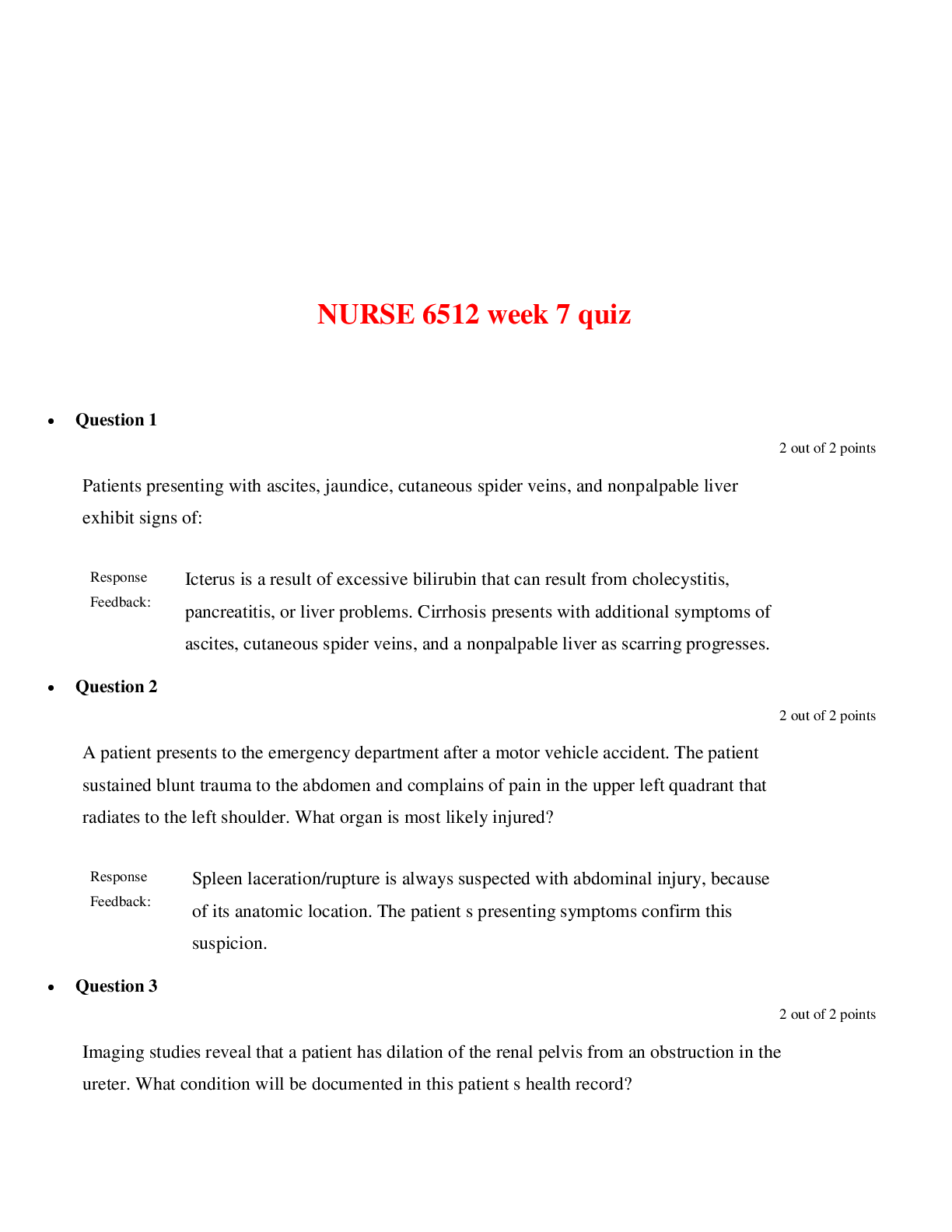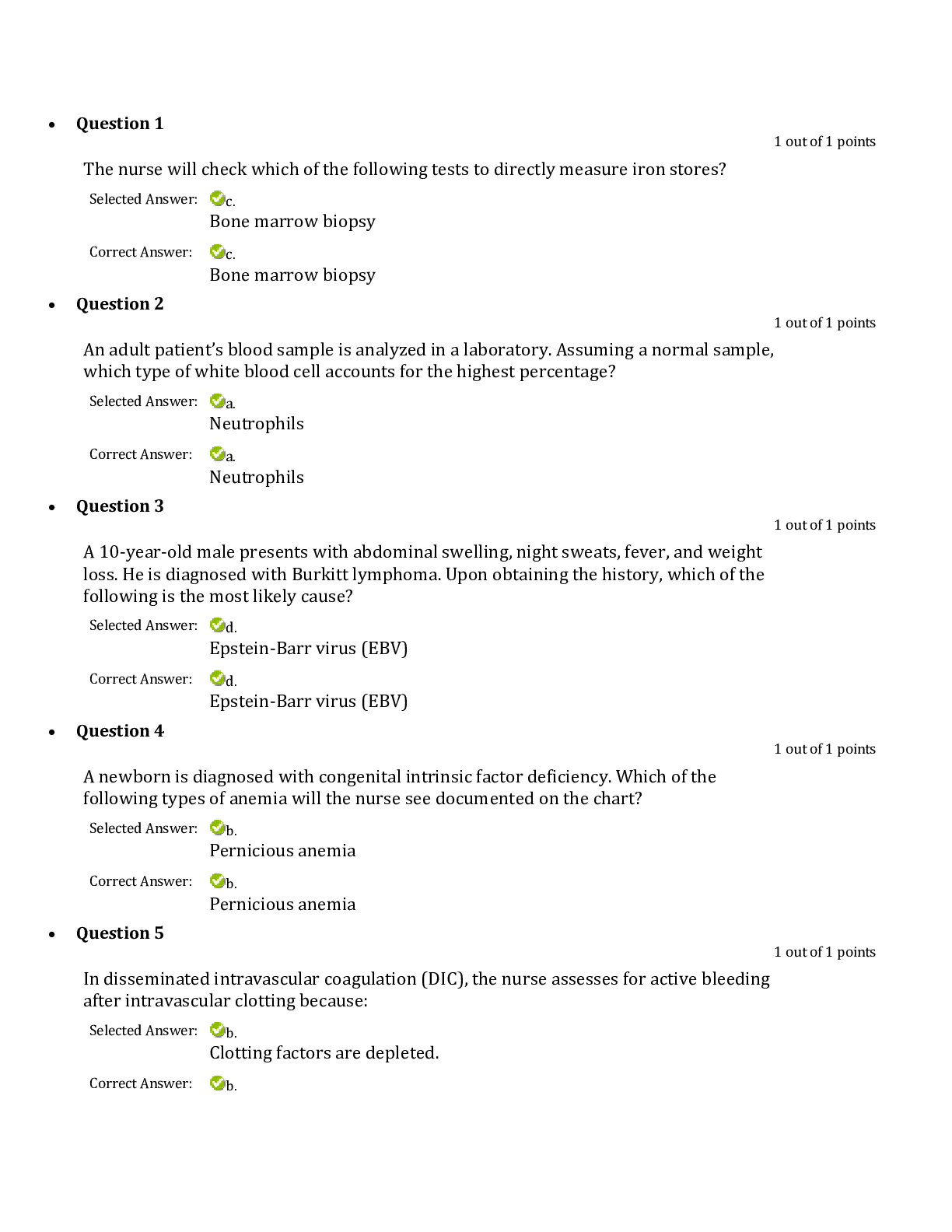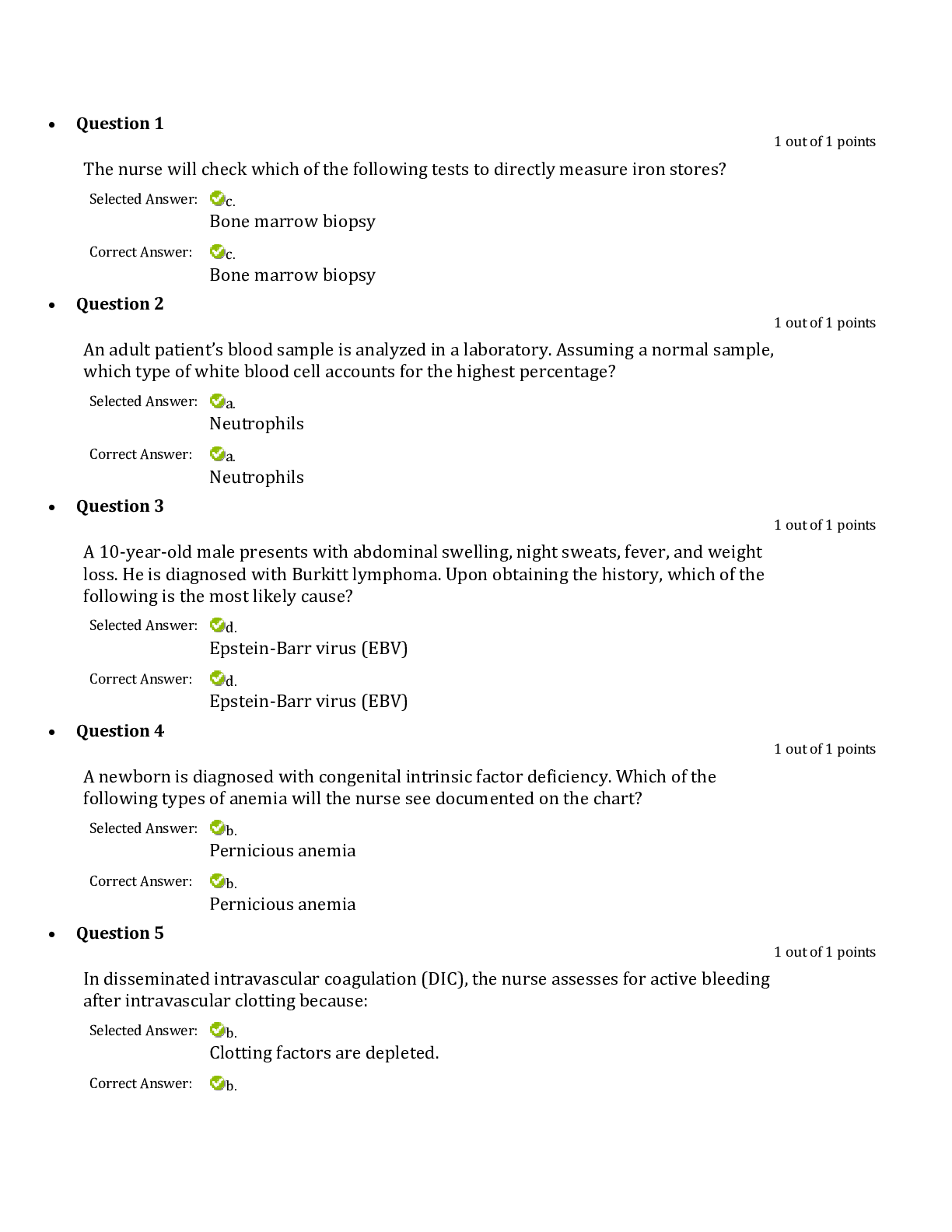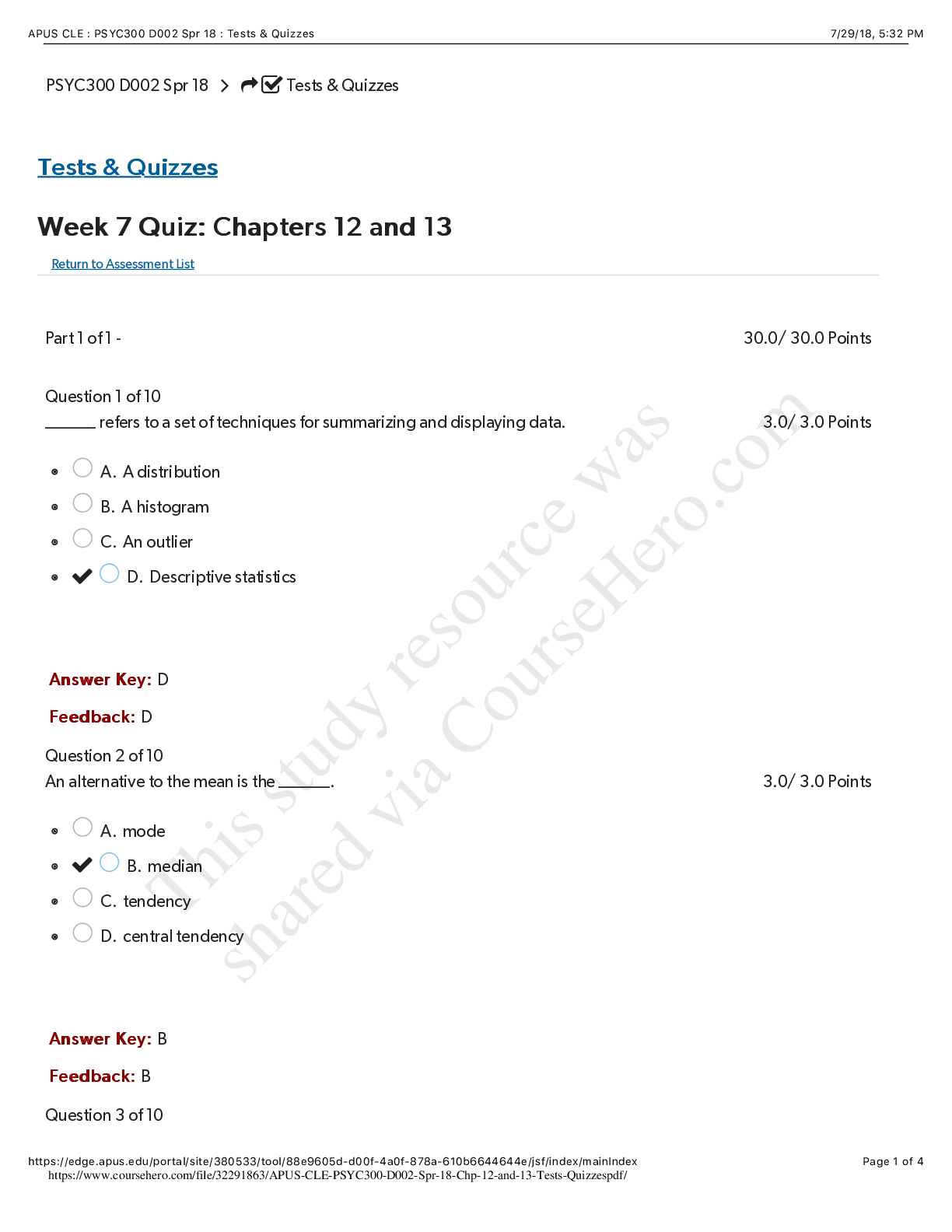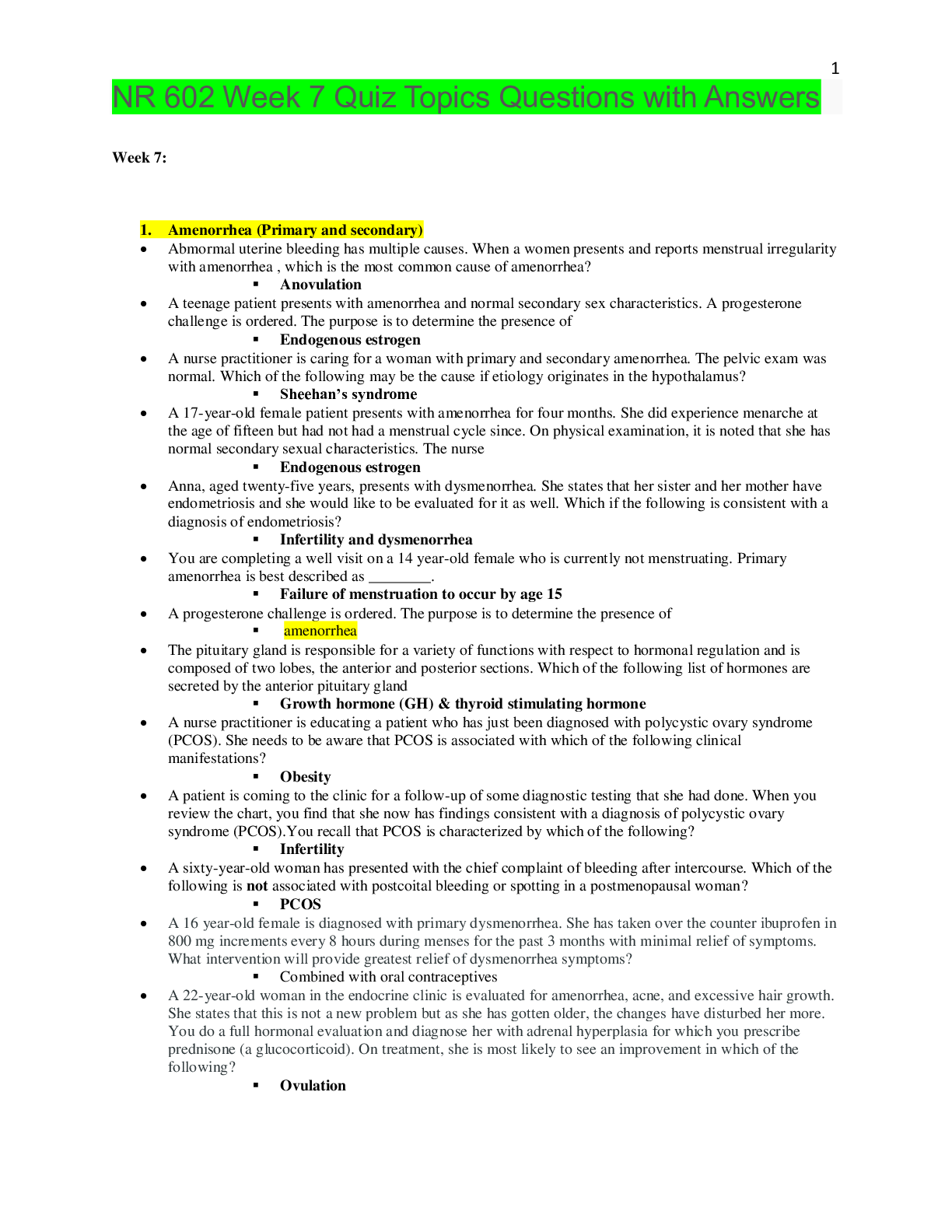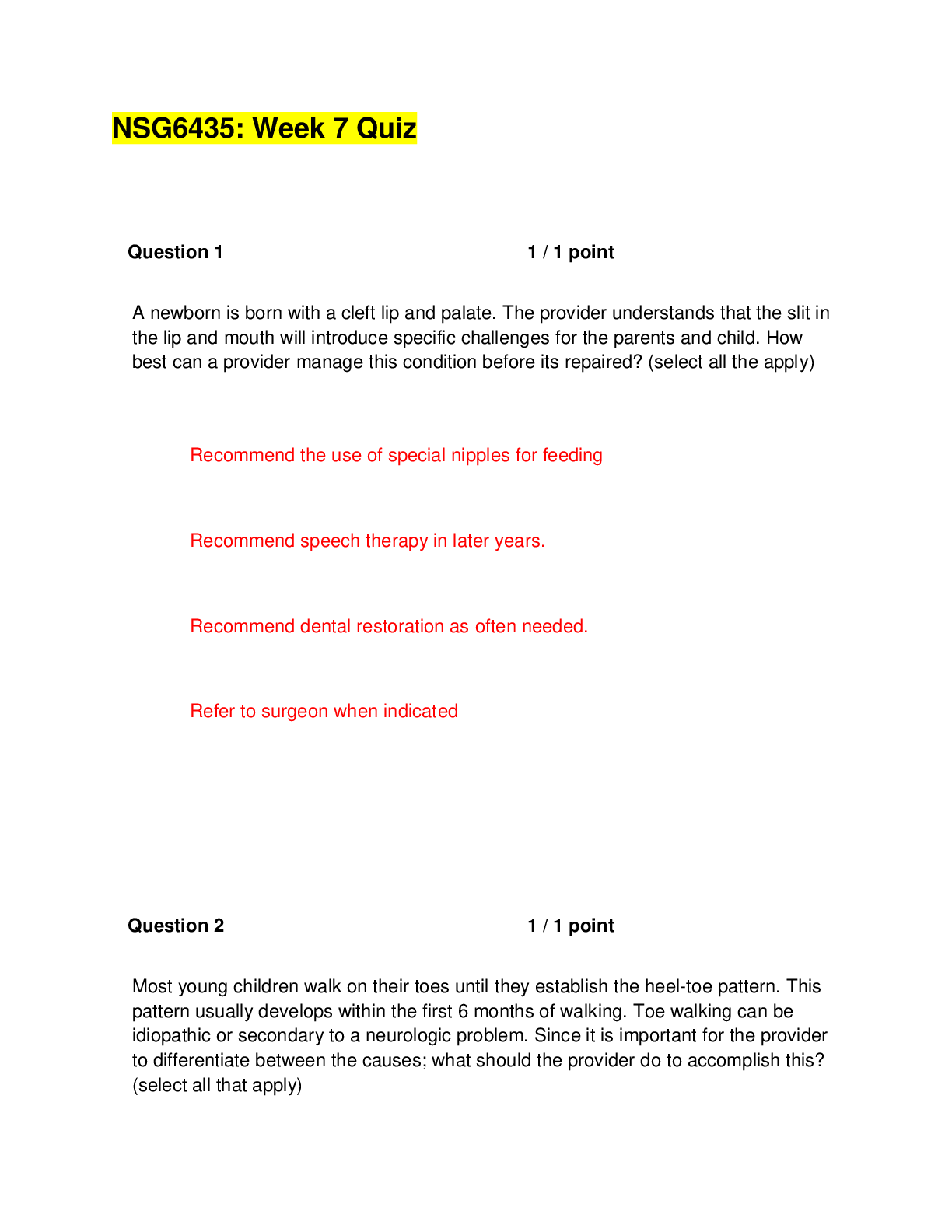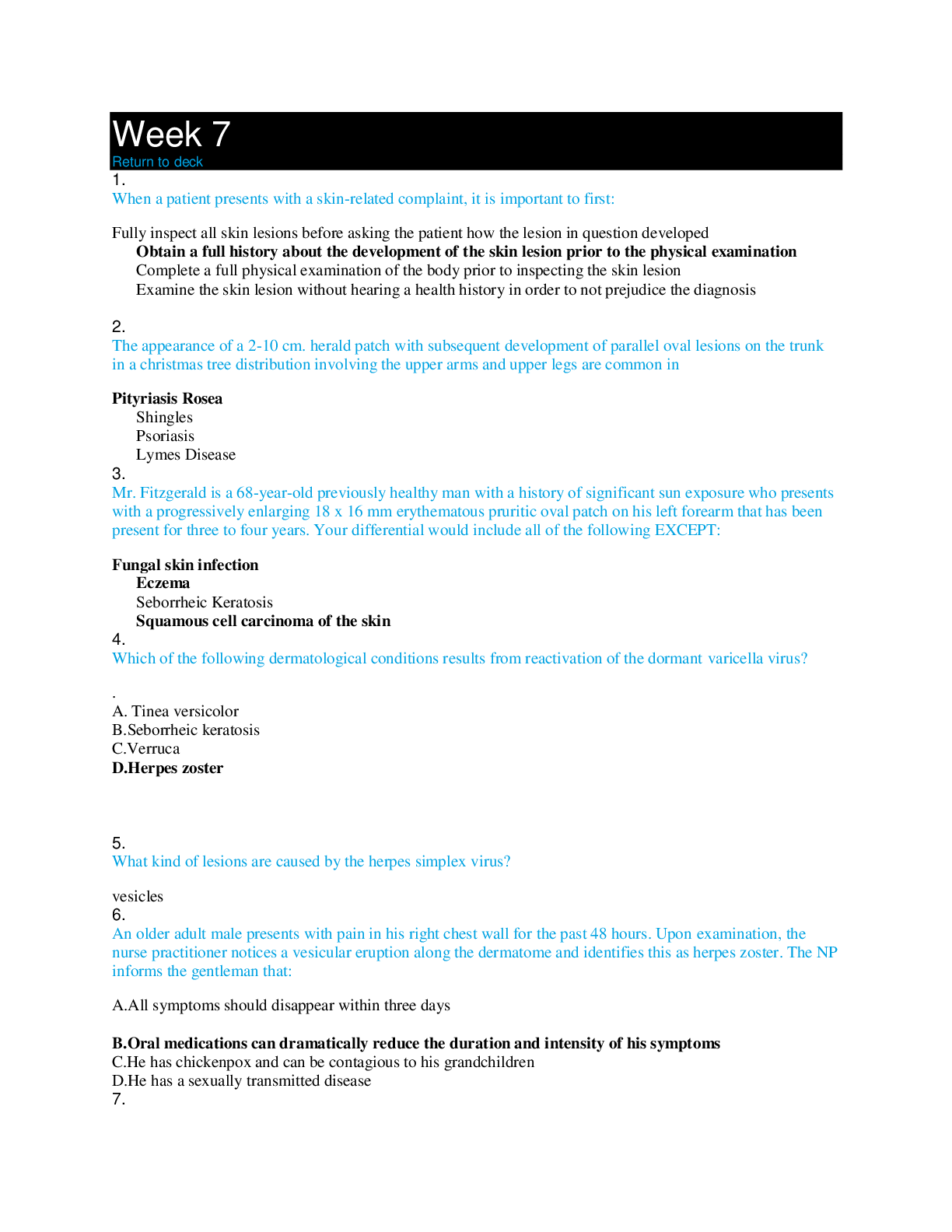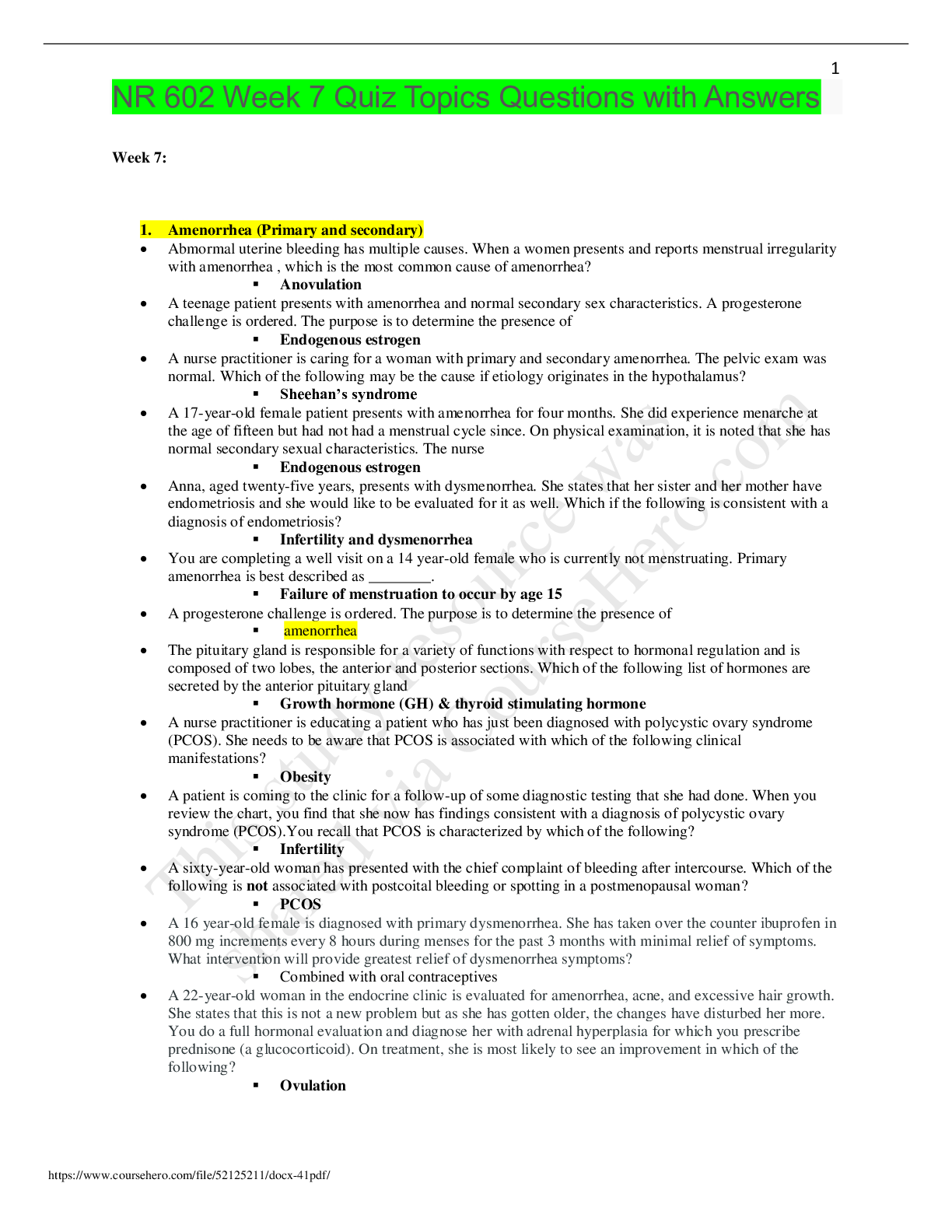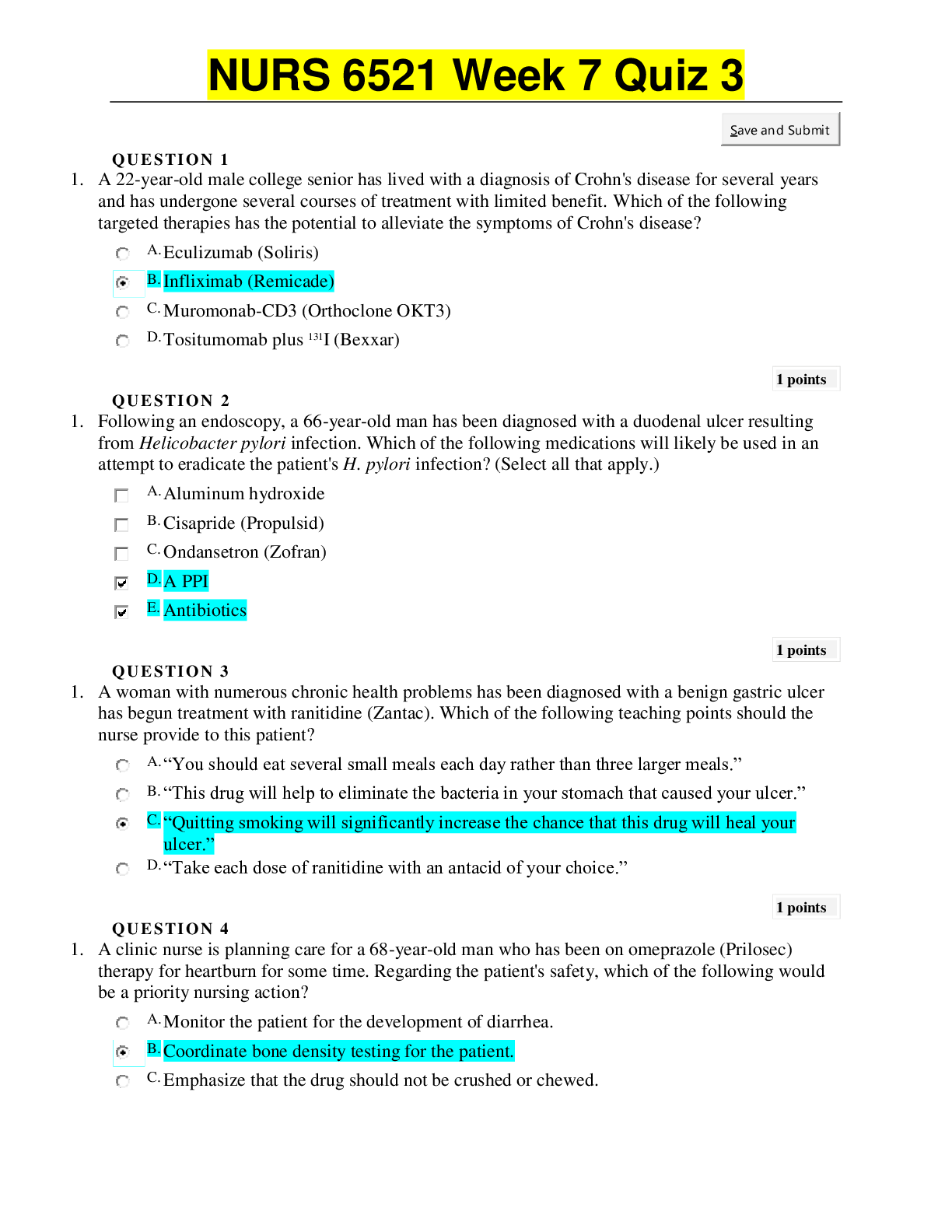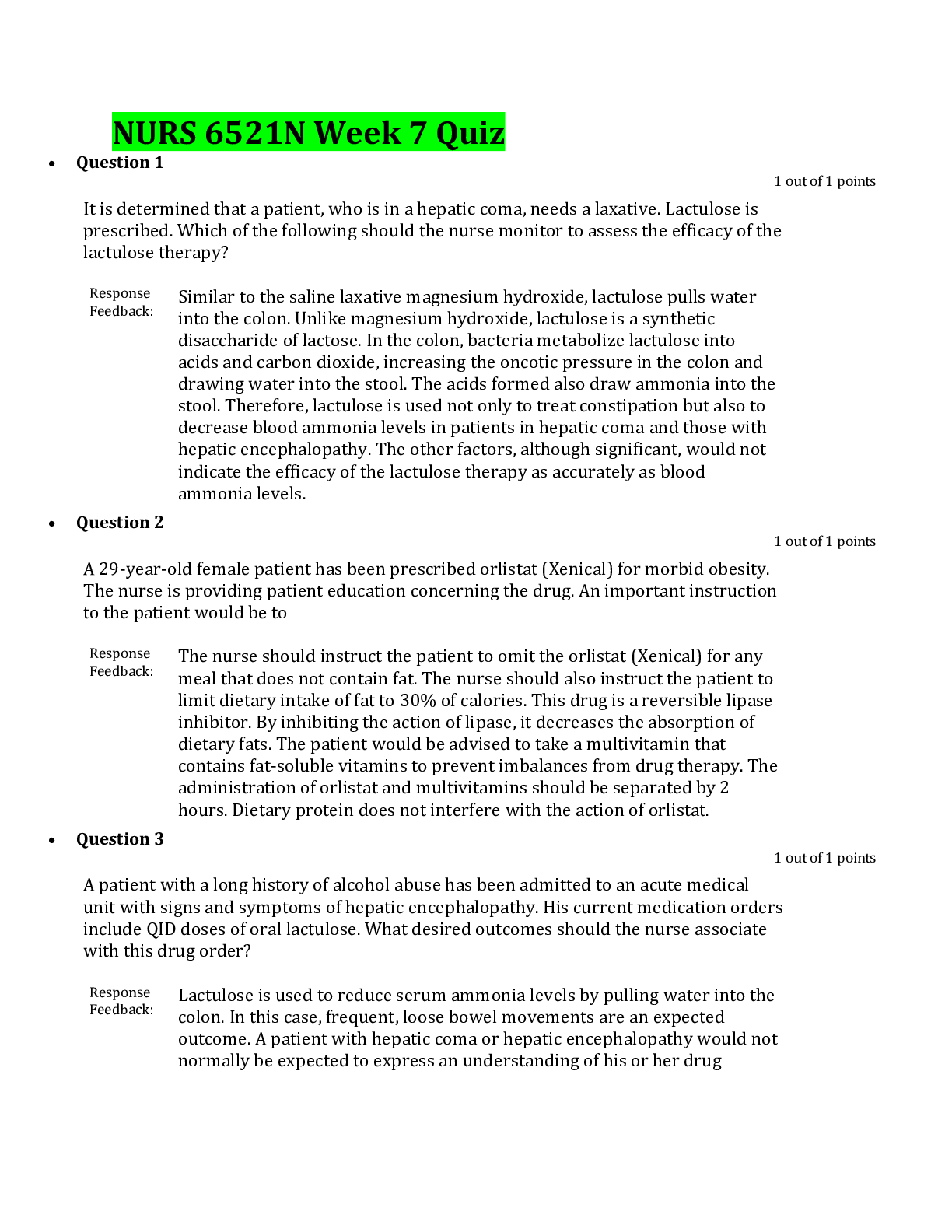NSG 6435 Week 7 quiz 2020 – South University | NSG 6435 Week 7 quiz 2020
Document Content and Description Below
NSG 6435 Week 7 quiz 2020 – South University NSG 6435 Week 7 Quiz 1. A newborn is born w/ a cleft lip & palate. The provider understands that the slit in the lip & mouth will introduce specific ... challenges for the parents & child. How best can a provider manage this condition before its repaired? (SATA) Recommend the use of special nipples for feeding Recommend speech therapy in later years. Recommend dental restoration as often needed. Refer to surgeon when indicated Feedback Surgical repair is indicated, the timing of which is individualized. Special nipples & feeding techniques are used until surgery can be performed. Breastfeeding & bottle feeding may be successful, depending on the severity of the cleft. Speech evaluation & perhaps therapy are necessary in later years. Dental restoration is often needed. Team management is preferred. Middle ear, nasopharyngeal & sinus infections, as well as associated hearing loss can occur. 2. Most young children walk on their toes until they establish the heel-toe pattern. This pattern usually develops w/in the 1st 6 months of walking. Toe walking can be idiopathic or secondary to a neurologic problem. Since it is important for the provider to differentiate between the causes; what should the provider do to accomplish this? (SATA) Look at shoe wear to assess extent of toe walking. Assess the heels for tight cords Conduct a neuro assessment. Measure leg lengths & examine hips. Feedback The PE should include all of the above. 3. An infant client is positive for moist, beefy-red macules & papules w/ sharply marked borders & satellite lesions to the diaper area. KOH-treated scrapings of satellite lesions show pseudohyphae. What is the most likely diagnosis? Tinea Miliaria Erythema toxicum Candidiasis Feedback Candida albicans, a yeast-like fungus, is commonly found on skin & oral, vaginal, & intestinal mucosal tissue. Although Candida is part of the normal flora, overgrowth & penetration of inflamed skin or mucous membranes can occur when there is a localized or systemic alteration in host defenses. Candidiasis is more common in infants, obese children, adolescents, & chronically ill or immunocompromised children. 4. A 15YO client presents to the clinic c/o tenderness to the right side. The pain started gradually & often radiates to the back. On exam the client is positive for Tietze syndrome. The provider diagnosis the client w/ Costochondritis. How should the provider treat this condition? (SATA) Recommend mild analgesics & NSAIDs Recommend avoiding strenuous activity Take cough suppressants Administer cortisone injections Feedback Costochondritis TX consists of using mild analgesia & NSAIDs to relieve discomfort & avoiding strenuous activity. Cough suppressants may be beneficial if cough is an aggravating factor. Stretching exercises & use of ice to the area can be useful. Parents & children need to be reassured that this is a benign self-limited condition & is not related to cardiac disease. 5. A 6YO client presents to the clinic c/o of an intermittent limp & pain to the anterior thigh. Upon exam, the following is noted: antalgic gait w/ limited hip movement, atrophy of the gluteus, quadriceps, & hamstring muscles; decreased abduction, internal rotation, & extension of the hip & pain on rolling the leg internally. What is the most likely diagnosis? Legg-Calvé-Perthes Disease Osteomyelitis Rheumatoid arthritis Gaucher disease Feedback Legg-Calvé-Perthes Disease is a childhood hip disorder that results in infarction of the bony epiphysis of the femoral head. It presents as avascular necrosis of the femoral head. The basic underlying cause of LCPD is insufficient blood supply to the femoral head. 6. A 9YO client in town for the summer presents to the clinic c/o a rash. Upon exam, the following is noted: multiple, annular, scaling & discrete hypopigmented patches located on the trunk. KOH scrapings of the lesions revealed short curved hyphae & circular spores that fluoresced yellow-orange under the Wood’s lamp. What is the most likely diagnosed? Tinea corporis Tinea manuum Tinea versicolor Tinea capitis Feedback Tinea versicolor is a superficial fungal infection, also called pityriasis versicolor that tends to be persistent & occurs predominantly on the trunk. The lesions do not tan in the summer & become relatively darker in winter months. 7. A 17YO client presents to the clinic c/o of small bumps all over the face. Upon exam, the following is noted: very small, firm, flesh-colored discrete papules 1 – 6mm in size located to the face, axillae & trunk. What is the most likely diagnosis? Molluscum contagiosum Condyloma acuminatum Small epidermal cysts Acne vulgaris Feedback A benign common childhood viral skin infection w/ little health risk, molluscum contagiosum often disappears on its own in a few weeks to months & is not easily treated. It is commonly found in children & adolescents. Infectivity is low but the child is contagious as long as lesions are present. 8. A 5YO client who presents to your clinic is found to have small white oval cases attached tightly to the hair shafts at the back of the head, nape of the neck & eyelashes. What is the best TX approach? Prescribe AntiFungals Prescribe AntiParasitics Prescribe combination medication consisting of AntiFungals & AntiParasitics Prescribe medication that follows local resistance patterns Feedback Lice infestation is caused by 3 subspecies, Pediculus humanus capitis & corporis (head & body) or by Phthirus pubis. The adult female louse, which survives by sucking human blood, deposits 6 to 10 eggs per day on a glue-like substance about 4 mm from the scalp on the hair shaft in a waterproof. TX failure is common, whether as a result of poor technique or actual medication resistance. It is recommended that providers follow local resistance patterns when determining TX. 9. A 4YO client reports to the clinic w/ visible scratch marks to the arms. The mother explains that the client is restless, cranky & scratches throughout the day which intensifies at night. On exam, the following is noted: S-shaped burrows in the webs of fingers, sides of hands & forearms. What is the most likely diagnosis & the most appropriate TX? Scabies; treat w/ AntiParasitics Insect bites; treat w/ AntiParasitics Scabies, treat w/ AntiFungals Insect bites; treat w/ AntiFungals Feedback Scabies is caused by the mite, Sarcoptes scabiei, which is an obligate human parasite that burrows into the epidermis & causes intense itching. TX is w/ AntiParasitics. 10. What are the key clinical signs & symptoms that are characteristic of the disease erythema multiforme? (SATA) Lesions of the oral mucosa that are shallow Lesions are fixed, symmetric, & have a typical distribution Lesions initially appear dusky, as red macules or edematous papules. Lesions evolve into target lesions w/ multiple, concentric rings of color change Feedback Erythema multiforme is an acute, usually benign, self-limited eruption characterized by target lesions & minor mucosal involvement (papules & varying bullae); it is rarely associated w/ complications. All the above symptoms apply. Overall Grade (highest attempt): 10 / 10 - 100 % [Show More]
Last updated: 1 year ago
Preview 1 out of 5 pages
Instant download
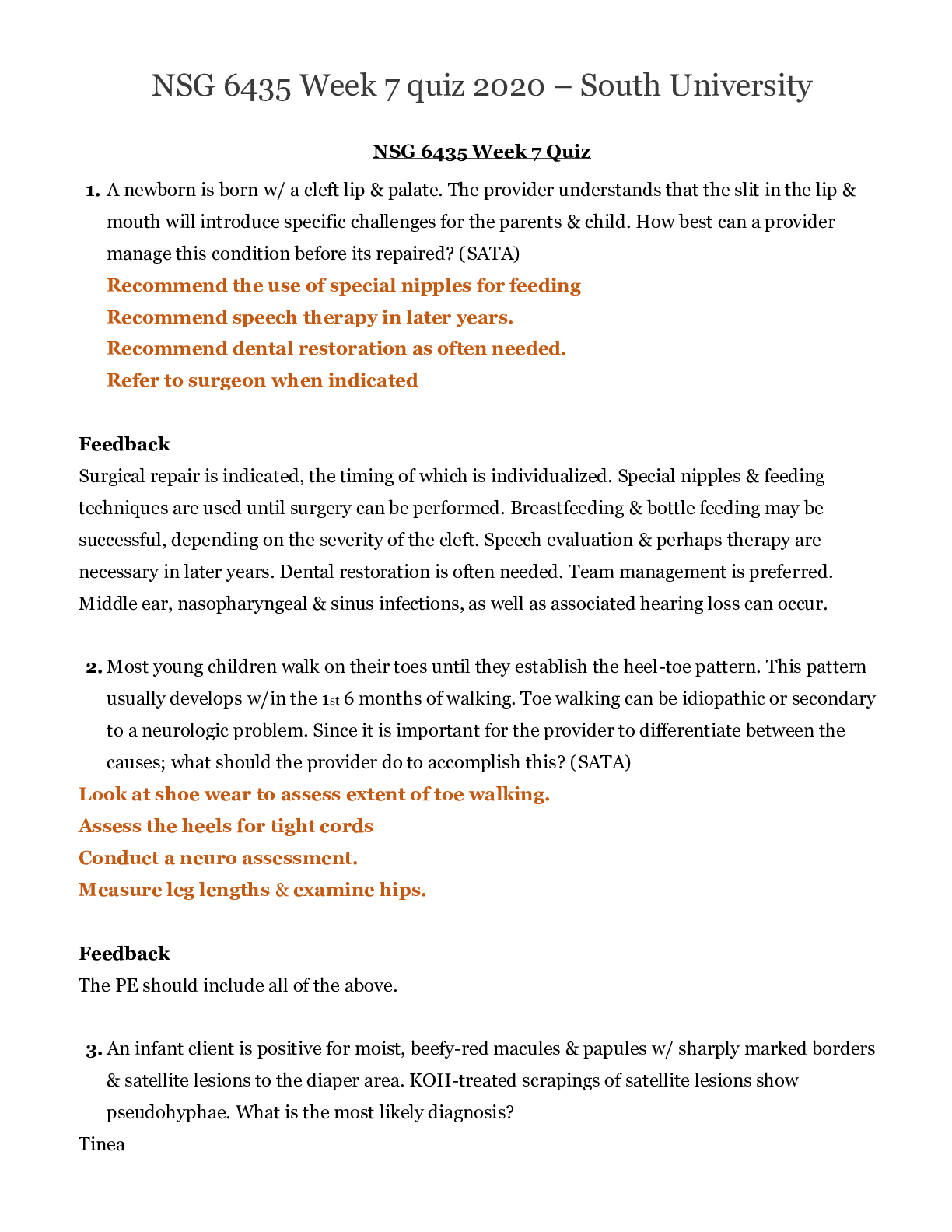
Buy this document to get the full access instantly
Instant Download Access after purchase
Add to cartInstant download
Reviews( 0 )
Document information
Connected school, study & course
About the document
Uploaded On
Jun 18, 2020
Number of pages
5
Written in
Additional information
This document has been written for:
Uploaded
Jun 18, 2020
Downloads
0
Views
22













